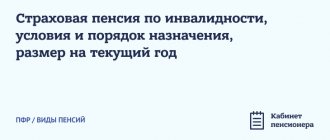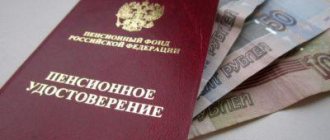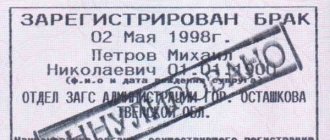You are going to retire in the near future (the nearest future is 2015).
In connection with the continuous pandemonium around the pension reform over the past few years (the funded part was either attached to the insurance part, then disconnected; it was then frozen, then unfrozen), registering a pension, especially determining its value, seems to be a difficult matter.
However, you will have to do this; going to the Pension Fund will be almost like going to work.
To reduce hassle, increase the chances of making the best choice, and reduce the time for collecting and processing documents, it is highly advisable to first familiarize yourself with the basic concepts, principles of calculating a pension and the list of necessary documents.
The legal basis for assigning a pension in the Russian Federation is Federal Law No. 173-FZ “On Labor Pensions”
with changes and additions constantly being made to it.
In accordance with it, there are currently three types of pensions in the Russian Federation:
- insurance pension
- state pension
- funded pension
Insurance pension
This is the pension that most citizens receive and will receive.
In essence, this is what was previously called a labor pension.
The base here is the length of service and the amount of earnings (but only the base! More details will be given below).
In turn, the insurance pension can be of three types:
- old age insurance pension
- disability insurance pension
- survivor's insurance pension
Old age insurance pension. While the retirement age has remained unchanged, it is known to everyone.
And since the beginning of 2015, changes have been made to the pension law (see Federal Law No. 400-FZ), namely:
- The later you apply for your pension, the greater it will be.
How much? An exact answer can only be obtained from the Pension Fund (PF).
The next change: to receive at least some kind of insurance pension in 2015, you must have at least 6 years of experience and a sum of pension points of at least 5.6 (however, the vast majority of citizens have much more of these points).
Please note: in the future, both the required amount of pension points and the required length of service will increase, gradually increasing, year by year.
And most importantly, the size of the pension will be determined using a rather complex method. The basics of this technique will be discussed below.
A disability insurance pension is assigned to disabled people of groups I, II and III with a minimum work experience.
An insurance pension for the loss of a breadwinner is assigned to disabled dependent family members of the deceased.
Amount of accruals to the Russian Pension Fund
So, the basic (general, cumulative) rate of contributions for compulsory pension insurance (hereinafter referred to as OPS) is 22 percent. Contributions to the Pension Fund are divided into 2 tariffs:
| Type | Size (%) | Purpose | ||
| Solidary | 6 | Formation of a fixed payment (hereinafter – FV) | ||
| Individual | 16 | Citizen's year of birth | Size (%) | Purpose |
| Until 1966 inclusive | 16 | Financing the future insurance part of the old-age pension | ||
| 1967 and later | 10 | |||
| 6 | Formation of the funded part of the benefit | |||
Additional tariffs for OPS
According to the Federal Law of the Russian Federation dated December 28, 2013 No. 426-FZ, containing lists No. 1, No. 2 and the so-called small ones, an additional tariff of insurance contributions to the Pension Fund of the Russian Federation has been introduced for those employing organizations that have workplaces with hazardous and/or hazardous industries. Increased rates apply to remuneration for certain categories of persons employed:
- in underground work, in hot shops, in hazardous industries according to list No. 1;
- certain types of activities provided for in small lists;
- at work with difficult and/or dangerous working conditions, related to list No. 2.
- Peptides for skin after 50 years
- A vegetable that detoxifies and lowers cholesterol
- Is it possible not to retire - the pros and cons of late retirement
In order for working conditions to be recognized as harmful and/or dangerous, the commission evaluates them. Experts identify relevant factors and the degree of their impact on human health, taking into account deviations from hygienic standards. The results of the inspection are the establishment of a hazard class, which is documented in the conclusion of the expert institution signed by all members of the commission:
| Hazard Class | Description | Additional tariff (%) | |
| 1 | Optimal effect on the body | No | |
| 2 | The conditions are considered acceptable, the employee’s health is restored during rest and/or at the start of a new shift. | ||
| 3 |
| According to the degree of harmfulness, there are 4 subclasses: | |
| 3.1 | 2 | ||
| 3.2 | 4 | ||
| 3.3 | 6 | ||
| 3.4 | 7 | ||
| 4 | Dangerous working conditions that pose a threat to the health and life of the employee, the possibility of developing an occupational disease | 8 | |
State pension
State pension is:
- for long service . It will be received by military personnel, federal employees (including law enforcement officers) and some other categories (for example, astronauts).
- by old age . Assigned to citizens affected by radiation or man-made disasters.
- social pensions . These are disability pensions for the loss of a breadwinner for disabled family members of the deceased from the categories of citizens mentioned above. Finally, these are pensions for people who, for one reason or another, do not have any rights to an insurance pension at all (for example, long-term homeless people).
You will probably be interested in looking at the mental map “Pension Insurance (SNILS)”, which explains in detail the procedure for its registration
Or HERE you will find out what benefits are available to old-age pensioners
How does reinstatement work? Court decision:
What codes should I use?
To make a transfer to the budget, a citizen must indicate the BCC. These are special codes that consist of 20 digits. The Ministry of Finance is responsible for determining them. Numbers are not selected randomly. Each code contains a certain amount of encrypted information. By being able to decipher it, a person will be able to obtain detailed information about the payment. The classic KBK is divided into four parts.
It reflects the following information:
- recipient of funds. Sometimes he is called an administrator. The first 3 characters indicate the recipient of the amount. So, if the payment is made to the Pension Fund, the BCC will start with 392;
- type of income. Numbers from 4 to 13 inclusive are used for indication. This part also has a certain gradation. It consists of 4 components. The first of these denotes the so-called group. This is the 4th sign of the KBK. It reflects income. So, if you need to pay insurance premiums, a unit is entered. The next, sixth, digit represents a subgroup. Depending on the characteristics of the transfers, combinations 02, 09 or 16 can be used. Payment item and subitem. For fixation, numbers from 7 to 11 inclusive are used. Information is entered in accordance with the information contained in the settlement documents. The final point is the so-called element. It is designated by the 12th and 13th digits of the KBK. It allows you to determine the budget level. If money is sent to the Pension Fund, combination 06 can be used. However, sometimes 01 or 08 is indicated instead;
- To divide the penalty, so-called program signs are used. They include KBK numbers from 14 to 17;
- the last 3 digits represent the so-called economic classification. If it is necessary to make contributions to an insurance pension, 160 is usually fixed. However, there are exceptions. So, instead of this combination, 140 can be specified.
If a citizen needs to find out the KBK, he must visit the official website of the Federal Tax Service. All codes used this year with detailed descriptions are collected here.
Calculation of insurance pension
Let's move on to the most interesting, but at the same time difficult to accurately calculate topic - the method for determining the amount of the insurance pension.
This methodology is set out in Federal Law No. 400-FZ of December 28, 2013 “On Insurance Pensions”
:
- SP = FC + PB x SB x PC
- SP – amount of insurance pension
- FC – fixed (in rubles) payment
- PC – premium coefficient
- PB – pension points
- SB - cost (in rubles) of one pension point
- The PF for 2015 is set at 4,383 rubles, and it increases for people over 80 years old and disabled people, for “northerners”; for persons who have dependent disabled family members. In addition, it will increase by 6% for each year of service over 30 years for men and over 25 years for women.
- PC – bonus coefficient for later retirement. So, if overworked for more than 1 year, PC = 1.07; reworked for 5 years – PC = 1.45, etc. (but the relationship is not linear!)
- SB – ruble value of one pension point. Set annually by the government, for 2015 it is 64.1 rubles/point.
- PB - the total amount of pension points for your entire career. The most important part, depending only on the person himself. And the most difficult to determine, you will need to strain your brain convolutions.
The pension point is calculated for each year using the following method:
- the employer's insurance contributions for the year are summed up (the same 16% that the employer transferred for the employee to the Pension Fund), this amount is divided by the annual insurance contributions from the maximum taxable salary, then multiplied by 10.
And you're done! It's clear, isn't it?
Let's give a numerical example:
For example, an employee receives 25 thousand rubles per month. 16% of insurance premiums for the year amount to 57.6 thousand rubles.
The maximum taxable salary for 2015 is 711 thousand, and the total insurance fees from them are 113.76 thousand rubles.
Then the pension point for the year will be equal to:
- 57.6: 113.76 x 10 = 5.06 points.
If you work this way for 30 years, you will earn 152 points.
Now you need to multiply these 152 points by the value of the point (what will it be in thirty years - can anyone tell?) - and you will receive your pension (do not forget to add the fixed pension payment, which in 30 years will be completely different from today).
The only trouble is that we live in a transition period, so the question arises: how to take into account the length of service before 2002; this method is not applicable to this period!
The Pension Fund somehow managed to create a method for converting those ancient years into today's rubles.
Alas, this technique is beyond the power of a mere mortal.
So almost until the very end of pension troubles, the exact figure of the pension will be very vague.
One thing is clear: a large salary and long work will significantly increase the amount of your pension points.
If you are really impatient, turn to your son, daughter, grandson, granddaughter.
They are young, advanced people, probably familiar with computers.
Ask them to go to the Pension Fund website and click on “Pension calculator” there.
A table will appear in which you must enter the requested data.
And the calculator will, with some accuracy, indicate the size of the future pension (which, however, will probably differ from the one calculated by the Pension Fund.
Don't be upset, man, that is. you too tend to have high expectations).
Categories of insurance premium payers
Payers of insurance premiums, otherwise policyholders, are persons who must, in accordance with clause 2 of Art.
6 of the Law “On the Basics of Compulsory Social Insurance” dated July 16, 1999 No. 165-FZ, transfer insurance contributions for compulsory social insurance to extra-budgetary funds. Payers of insurance premiums are persons who pay individuals for work performed under concluded labor and civil law contracts.
The legislation establishes who belongs to the payers of insurance premiums (Article 419 of the Tax Code of the Russian Federation):
- Russian and foreign organizations, branches and representative offices of foreign companies that are established on the territory of the Russian Federation;
- Separate divisions of organizations located on the territory of the Russian Federation, if they independently make payments to individuals for work performed, and also use their own current account, submit reports, and have a separate balance sheet;
- individual entrepreneurs, which also include private detectives (clause 4 of article 1.1 of the Law of the Russian Federation of March 11, 1992 No. 2487-1 “On private detective and security activities in the Russian Federation”) and heads of peasant or farm enterprises;
- individuals who use the services of any persons to resolve their own issues (for example, apartment renovation, design work, etc.), but are not individual entrepreneurs.
See also:
- “Insurance premiums from foreigners in 2019-2020”;
- “What insurance premiums does an individual entrepreneur pay in 2021 - 2020.”
Calculation of funded pension
(This section applies only to men born in 1953 and younger and women born in 1957 and younger.)
It’s possible that at least part of your working life you participated in creating the funded part of your pension (or rather, your employer paid another 6% to the Pension Fund).
In this case, you will receive, in addition to the insurance pension, a second funded pension.
It's entirely your money; if you haven’t managed to spend them in your life (we are all mortal), the remainder will go to your heirs.
So, if you are participating in the creation of a funded pension, be sure to receive letters from the Pension Fund once a year, which indicate two figures - funded accruals for the past year and the total amount of accruals.
(If there is no such letter, run to the Pension Fund).
The size of the funded pension is approximately determined very simply:
- NP = SPN: T
- Here SPN is the amount of pension savings (the one named in the PF letter)
- T – number of months of payment; today it is 228 months.
You can find out more accurately your funded pension using a computer.
On the Internet you need to find and go to the website of any non-state pension fund (for example, the Soglasie fund, or Gazfond, or any other).
There certainly is a “Pension calculator” window; fill out its lines and get the amount of your funded pension.
Tariffs of insurance premiums for compulsory health insurance
According to the new version of Art. 33.1 of the Law on Pension Insurance, the basic rate of insurance premiums in 2014 - 2016 for insurers-organizations is:
- 22% within the established limit of the base for calculating insurance premiums;
- 10% above the established maximum base for calculating insurance premiums.
For persons born in 1966 and older, the amount of insurance contributions paid by employers is fully used to finance the insurance part of the labor pension.
For persons born in 1967 and younger, two pension options have been developed:
1) all contributions accrued at a rate of 22% are credited to the insurance part of the labor pension, respectively, 0% is credited to the savings part (that is, pension savings are not formed);
2) to finance the insurance part of the labor pension, the amount of insurance contributions accrued at a rate of 16% is credited, to finance the funded part - at a rate of 6%.
In this case, these persons must independently choose one of the listed pension options, that is, either the insurance premium rate is 6% or 0%, thereby refusing to form pension savings and directing all insurance contributions that employers pay for them to the formation of the insurance part labor pension.
The insured person can exercise this right by submitting an appropriate application to the territorial body of the Pension Fund of the Russian Federation. Based on this application, the territorial body of the Pension Fund is obliged to reflect the pension option chosen by the insured person on his individual personal account within the time limits established by the legislation of the Russian Federation, taking into account the features provided for by the Law on Pension Insurance ( clause “a”, clause 7, article 6 of the Federal Law No. 351-FZ ).
As for insurance premiums, calculated by employers additionally at a rate of 10% from amounts exceeding the established maximum base for calculating insurance premiums, they are credited to finance the insurance part of the insured person’s labor pension, regardless of his age.
Let us recall that in 2014, the maximum value of the base for calculating insurance premiums is 624 thousand rubles ( Resolution of the Government of the Russian Federation of November 30, 2013 No. 1101 “On the maximum value of the base for calculating insurance premiums to state extra-budgetary funds from January 1, 2014” ).









